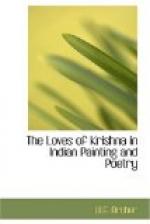Note 14, p. 68.
Wilson (op. cit., 608) summarizing the portents listed in the Mahabharata but not included in the Vishnu or Bhagavata Puranas.
Note 15, p. 72.
From the Brihadaranyaka, quoted A. Danielou, ’An Approach to Hindu Erotic Sculpture,’ Marg, Vol. II, No. i, 88. For a Western expression of this point of view, compare Eric Gill, ‘Art and Love,’ Rupam (Calcutta, 1925), No. 21, 5.
’If the trees and rocks, the thunder and the sea, the frightful avidity of animal life and the loveliness of flowers are so many hints of the God who made them, how much more obviously are the things of humanity analogues of the things of God? And among all such things, the union of man and woman takes the highest place and is the most potent symbol. Therefore it is that outside the commercial civilizations of the western world, love and marriage take their place as types of divine union and everywhere love and marriage are the subject matter, the theme of religious writers, singers, painters and sculptors. It is true that love is the theme of western writers also but with them the idea of love is entirely free from divine signification. (As a corollary), the more the divine background disappears, the more the prudishness of the police becomes the standard of ethics and aesthetics alike. Under such an aegis the arts are necessarily degraded to the level of the merely sentimental or the merely sensual and while the sentimental is everywhere applauded, the sensual is a source of panic.’
Note 16, p. 73.
In later poetry as well as in popular worship, Radha’s position is always that of an adored mistress—never that of a beloved wife. And it is outside or rather in the teeth of marriage that her romance with Krishna is prosecuted. Such a position clearly involved a sharp conflict with conventional morals and in the fourteenth century, an attempt was made, in the Brahma Vaivarta Purana, to re-write the Bhagavata Purana, magnifying Radha as leader of the cow-girls, disguising or rather denying her adultery and finally presenting her as Krishna’s eternal consort. For this purpose, three hypotheses were adopted. Radha was throughout assumed to be Krishna’s spouse and it is only on account of a curse that she takes human form as a cowgirl and comes to live in Brindaban. Radha herself does not marry Ayana the cowherd—his wedding being only with her shadow. Thirdly, Krishna comes to Brindaban and goes through a secret marriage with her. Their love-making is, therefore, no longer adulterous but strictly conjugal. It is not perhaps surprising that the Brahma Vaivarta Purana failed to capture the Indian imagination and indeed is nowadays hardly ever heard of. It is of interest mainly on account of the prolific information given about Radha, the fact that it sets her firmly in the centre, dethroning the hapless Rukmini, and its baroque descriptions of sexual union.




